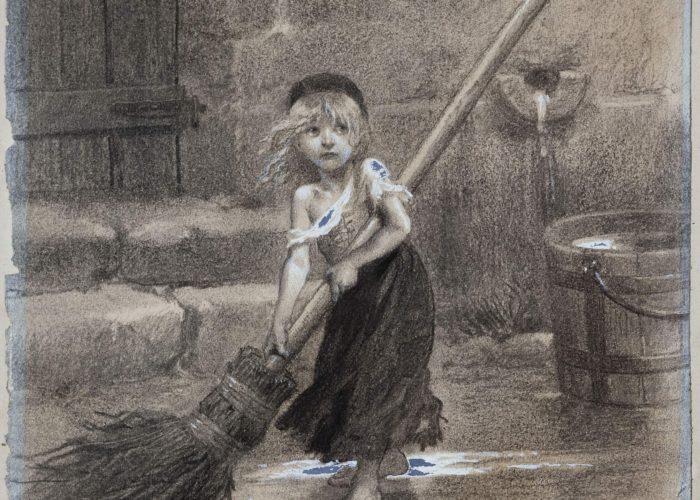Cosette Sweeping
Cosette, is a central character in Victor Hugo’s novel, Les Misérables, an epic story with revolution at its very heart. First published in 1862, Hugo’s tale is one of the longest novels in history. It is widely considered to be a masterpiece and has been adapted countless times for stage and screen.
Les Misérables is set in France during the aftermath of the Battle of Waterloo and the French Revolution. It centres around the character Jean Valjean and his search for redemption. After a promise to her dying mother, Valjean dedicates himself to ensuring Cosette’s safety and happiness. Meanwhile, he is relentlessly pursued by Inspector Javert, who believes Valjean has broken his parole as a former criminal. With this story as its central focus, the novel explores themes of hardship, social unrest, political turmoil and revolution in early 19th century France.
Les Misérables took Victor Hugo over 17 years to devise and finally publish. The author, a key figure in the French Romantic Movement, had been a royalist in his youth but turned into a committed and passionate republican. Begun in 1845, the outbreak of the 1848 Revolution in France led him to shelve the book for 12 years. He finally completed the novel in exile in Guernsey, having left France when Napoleon III seized power in 1851. Around 1900 pages long, in the original French, it was published in five instalments in 1862 and, despite scathing critical reviews, became a global bestseller. In Hugo’s words, “so long as ignorance and misery remain on earth, books like this cannot be useless.”
This illustration of Cosette as a young girl was created by Èmile Bayard. It has become symbolic of the entire story and used over and over again, most famously on posters for Boublil and Schöenberg’s musical. Cosette’s character as a child faces poverty, starvation, and forced labour but through education and compassion is reprieved – a theme of many reformers of the age.
Did You Know..?
Opened in 1985, with English lyrics by Herbert Kretzmer, Les Misérables is the longest running musical in London.
Sources & acknowledgements
This object description and its related educational resources were researched and written by our team of historians and education specialists. For further information see the item’s home museum, gallery or archive, listed above.
-
Education overview
You can access a range of teachers resources related to this object and more on our education page.
Please also see our glossary of terms for more detailed explanations of the terms used.
-
Curatorial info
- Originating Museum: Maison de Victor Hugo - Hauteville House
- Accession Number: 349
- Production Date: 1879 - 1880
- Creator: Bayard, Emile-Antoine
- Size: 44.5 cm x 27 cm
- Original record
-
Use this image
“Cosette”. Illustration for “Les Misérables” by Victor Hugo. Charcoal by Emile-Antoine Bayard (1837-1891). Paris, Maison de Victor Hugo.
You can download this image for personal and educational use but please take note of the license type and rights holder information.
- Rights Holder: © Roger-Viollet / TopFoto
- License Type: All Rights Reserved



